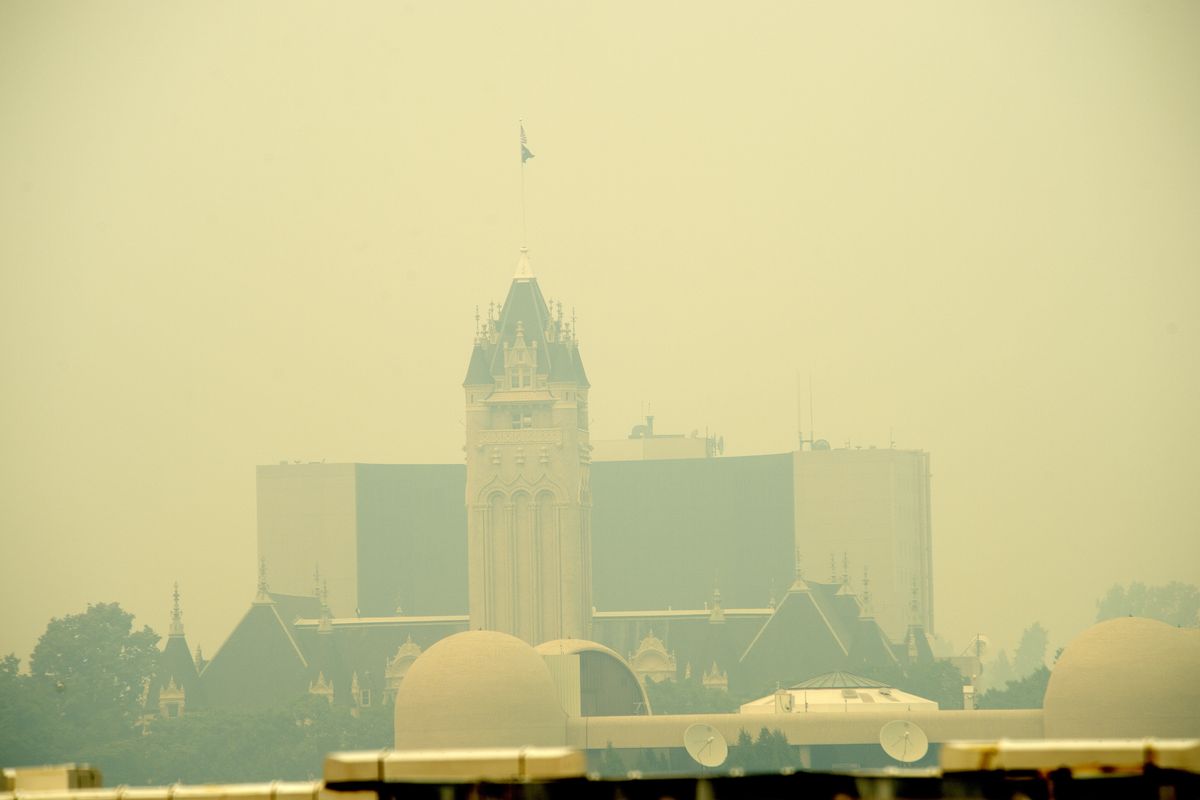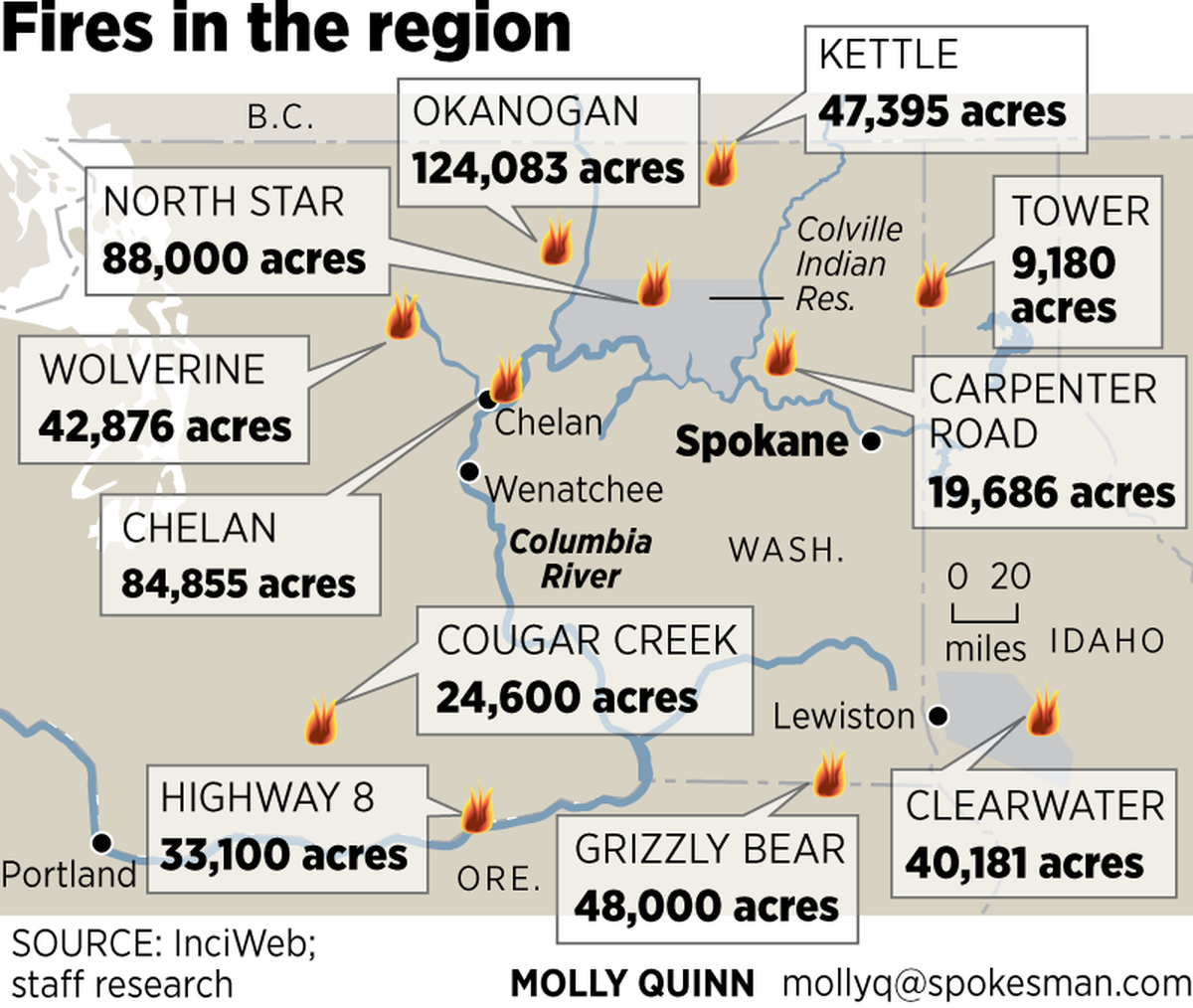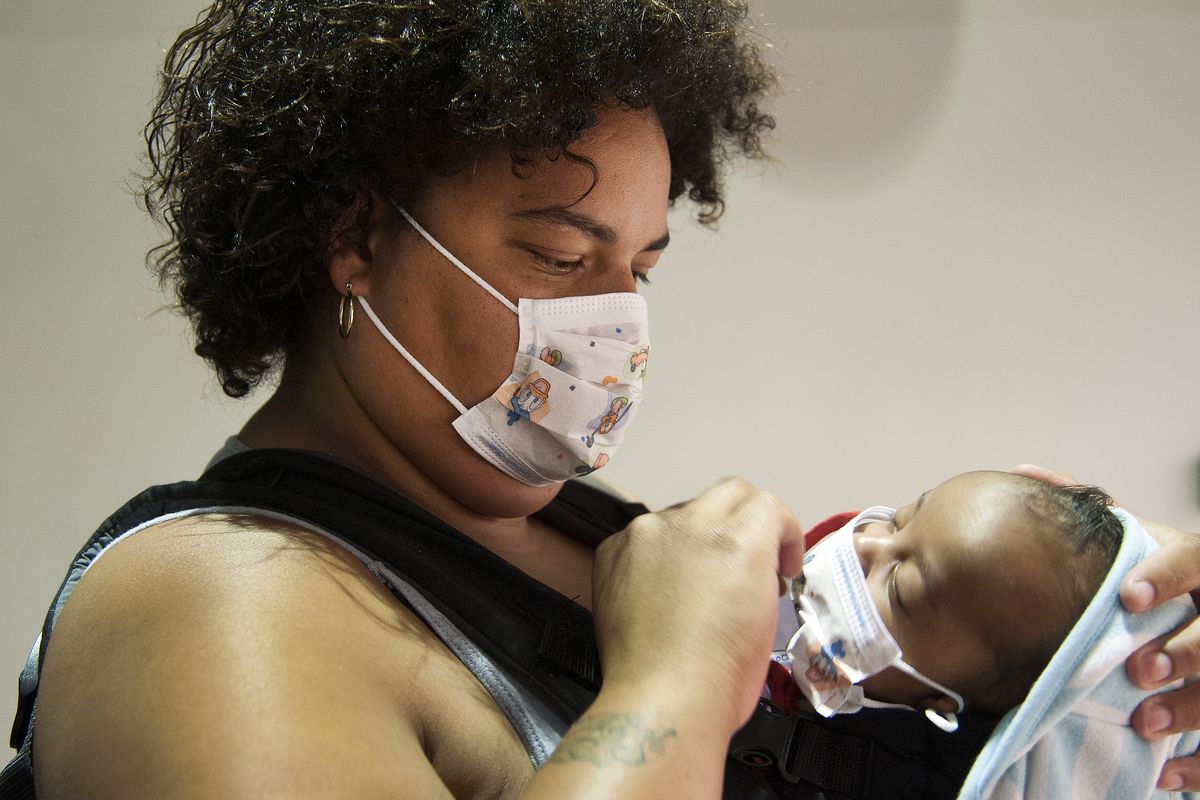Air quality plummets as smoke covers region like blanket
Kira Leeper, 27, adjusts a mask on her son, Kamrin, 11 weeks, as they wait for a bus inside the STA Plaza on Friday afternoon. (Dan Pelle)Buy a print of this photo
Spokane’s air deteriorated on Friday to levels that previously seemed unreachable as satellite images showed smoke pouring into the region from numerous massive fires in Central Washington.
By the afternoon, the strong scent of campfire was unavoidable and the air was considered unhealthy for all. By the evening, the air – according to the Spokane Regional Clean Air Agency’s Spokane Valley monitor – reached the most critical category, “hazardous.”
“I haven’t seen levels like that since I’ve worked there,” said spokeswoman Lisa Woodard, who has worked at the agency for about 20 years. “We don’t even have an icon designed for our website.”
In fact, the agency doesn’t even have an icon on its air quality website for the category just below hazardous – “very unhealthy.”
“We are definitely in unprecedented numbers for our region,” said Julie Oliver, the agency’s director.
Spokane’s smoke-filled skies Friday evening turned the Lilac City into the most air-polluted place in the country, according to readings from the federal Environmental Protection Agency.
The severe pollution extended from the Spokane Indian Reservation to Helena.
Experts said it was likely the poorest air quality in the region since Mount St. Helens erupted in 1980, sending a massive cloud of volcanic ash around the world.
Air quality started out Friday in the moderate range, but it worsened as plumes of smoke from regional wildfires blew in and a cold front arrived from the northwest.
Little relief is expected in the foreseeable future.
The forecast calls for continued unhealthy air today and Sunday, Oliver said.
She said the agency’s website was overwhelmed with people trying to get information. “We’ve had phones ringing nonstop,” she said.
The EPA’s air pollution readings are available at airnow.gov, though Oliver said readings from the EPA site late Friday appeared to be incorrect.
The National Weather Service is calling for areas of smoke throughout next week.
Health officials are urging people to limit time spent outside, avoid exercising and choose non-strenuous indoor activities. Make sure all windows and doors are closed and turn on the furnace fan if there is one. A high-efficiency air filter should be used, if available.
People with asthma, respiratory infection, diabetes, heart and lung disease or with a history of stroke should especially stay indoors. Pregnant women, infants and children should also stay indoors.
Dr. Joel McCullough, health officer at the Spokane Regional Health District, said even healthy people experience symptoms from poor air quality. That includes irritated eyes and throat. People with chronic heart or lung diseases may experience a worsening of their symptoms, he said.
“We’re recommending that most people be indoors as much as possible,” McCullough said.
Steve Kernermen, a doctor at the Spokane Allergy and Asthma Clinic, said he’s been seeing an uptick in patients with asthma and upper respiratory problems all week.
“This smoke is only making that worse,” he said. “I wish there was more we could do to clear the air but there’s literally nothing we can do except wait for the wind to shift or rain to fall.”
Providence Sacred Heart Medical Center hasn’t seen an increase in emergency room visits, which probably means people needing care have been going to primary care doctors or urgent care, said spokeswoman Jennifer Semenza.
As a result of the poor air quality, Spokane Valley canceled an outdoor movie showing scheduled for tonight at Mirabeau Point Park. Open swim sessions at Valley pools also were canceled.
The city of Spokane closed its pools early Friday because of “poor air quality and low attendance,” said parks spokeswoman Monique Cotton. She said the pools might stay closed today if air quality remains poor.
A Spokane Indians game scheduled for Friday was postponed to Aug. 28.
A youth soccer tournament was canceled this weekend, and Greater Spokane League schools were expected to suspend practices because of the unhealthy conditions.
Ron Edgar, retired chemist for the clean air agency, said Spokane has seen its share of wildfire smoke over the years.
The Spokane area Firestorm in 1991 probably caused the most severe smoke pollution in recent history, but that was before Friday, he said.
It is difficult to compare the current smoke pollution with past events because the method for monitoring smoke pollution has changed.
But “we are certainly getting as much or more smoke than we did during Firestorm,” Edgar said.
Agricultural dust storms have blown over the region numerous times, and there were some severe ones over the years, he said.
But the Mount St. Helens eruption was the peak event.
“It’s hard to top a volcano,” he said.
People have been calling 911 with concerns about smoke in the region, the Spokane Fire Department said in a news release.
The Fire Department urged drivers to be cautious. Heavy smoke settled into many stretches of Interstate 90 and other highways in the area.
“We are closely monitoring the air quality as conditions have worsened due to smoke from numerous wildfires across Washington state,” Assistant Fire Chief Brian Schaeffer said.


